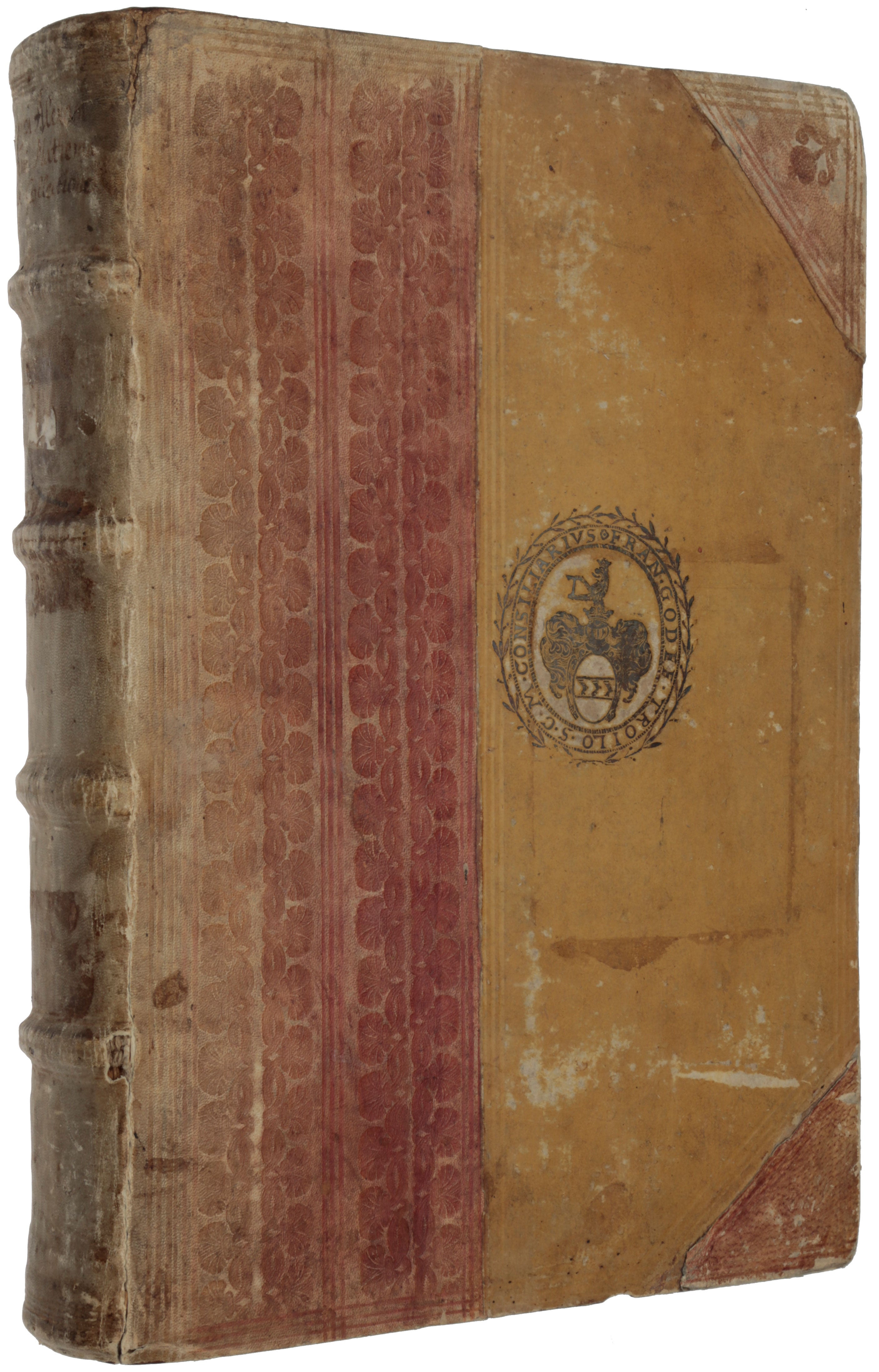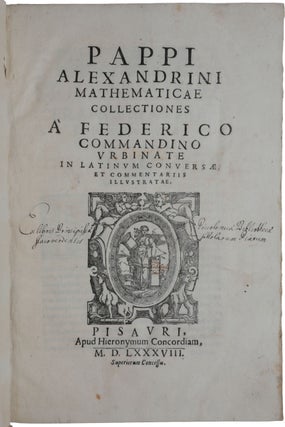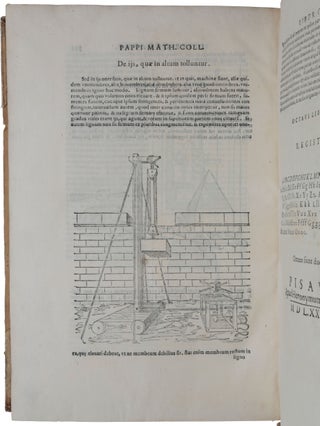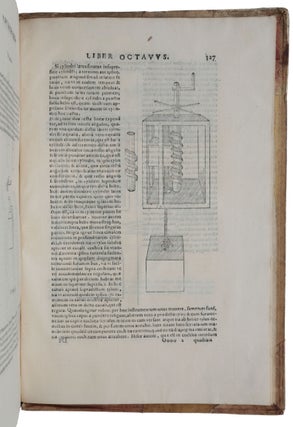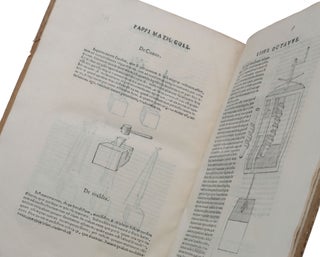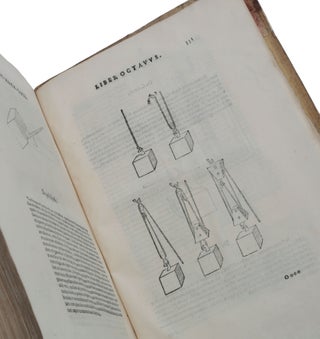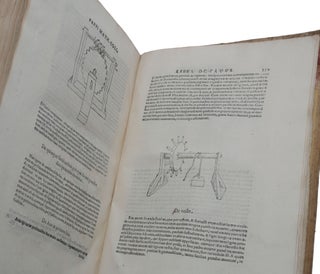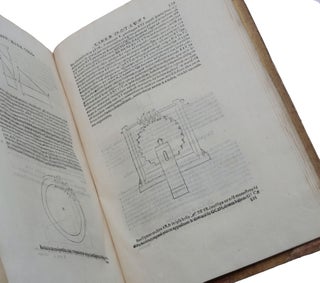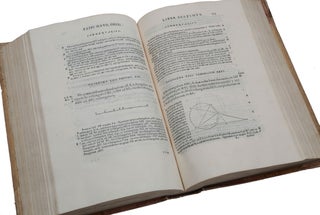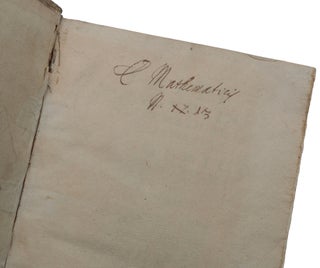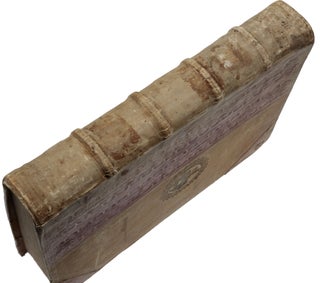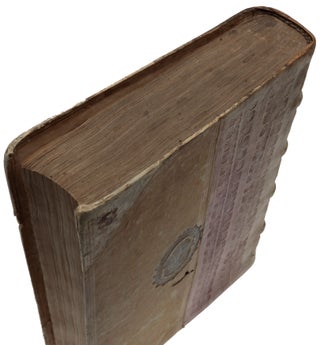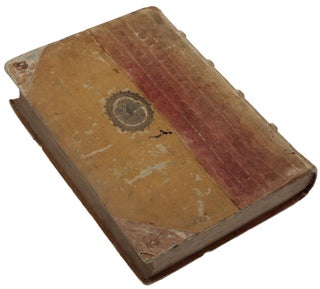Mathematicae Collectiones a Federico Commandino Urbinate in latinum conversae, et commentariis illustratae.
Pesaro: Girolamo Concordia, 1588. First edition of Pappus' Collection, translated with commentary by Federico Commandino, a princely copy from the notable collection of the great Papal family and patrons of learning, the Piccolomini, Dukes of Amalfi, thence by marriage to the German nobleman von Troilo. The Collection is “by far the most important of Pappus’ works … without it, much of the geometrical achievement of his predecessors would have been lost forever … The Collection deals with the whole body of Greek geometry, mostly in the form of commentaries on texts which it is assumed the reader has to hand. It reproduces known solutions to problems in geometry; but it also frequently gives Pappus’ own solutions, or improvements and extensions to existing solutions. Thus Pappus handles the problem of inscribing five regular solids in a sphere in a way quite different from Euclid; gives a broader generalization than Euclid to the famous Pythagorean theorem, and provides a demonstration of squaring the circle which is quite different from the method of Archimedes (who used a spiral) or that of Nicomedes (who used the conchoid).
Perhaps the most interesting part of the Collection, measured by its influence on modern mathematics, is Book VII, which is concerned with the problems of determining the locus with respect to three, four, five, six or more than six lines. Pappus’ work in this field was called ‘Pappus’ problem’ by René Descartes, who demonstrated that the difficulties which Pappus was unable to overcome could be got round by the use of his new algebraic symbols. Pappus thus came to play an important, if minor, role in the founding of Cartesian analytical geometry. And it is another mark of his originality and skill that he spent much time working on the problem of drawing a circle in such a way that it will touch three given circles, a problem sophisticated enough to engage the interest, centuries later, of both François Viète and Isaac Newton. For his own originality, even if his chief importance is as the preserver of Greek scientific knowledge, Pappus stands (with Diophantus) as the last of the long and distinguished line of Alexandrian mathematicians” (Hutchinson Dictionary of Scientific Biography). “He formally defined analysis and synthesis as they are still commonly applied in the solution of geometrical riders. Pappus stumbled upon the projective invariance of the cross-ratio of four collinear points and other related results reclaimed by modern projective geometry; and he gave the first recorded statement of the focus-directrix property of the three conic sections. He formulated the ‘centrobaric’ theorems, frequently attributed to Paul Guldin (1577-1643), for calculating the volume and surface generated by a plane figure rotating about an axis in its own plane. He discussed theoretical mechanics, the equilibrium of a heavy body on an inclined plane, the use of the mechanical powers, and the construction of mechanical toys” (Biographical Dictionary of Scientists). Provenance: Ex libris inscription of Princess Maria Piccolomini and signature of Count Franz Gottfried von Troilo on title; shelfmark on front free endpaper. Pappus of Alexandria (c. 290 – c. 350 AD) was the most important mathematical author writing in Greek during the later Roman Empire. Other than that he was born at Alexandria in Egypt and that his career coincided with the first three decades of the 4th century AD, little is known about his life. “In the silver age of Greek mathematics Pappus stands out as an accomplished and versatile geometer. His treatise known as the Synagoge or Collection is a chief, and sometimes the only, source for our knowledge of his predecessors’ achievements. The Collection is in eight books, perhaps originally in twelve, of which the first and part of the second are missing … The several books of the Collection many well have been written as separate treatises at different dates and later brought together, as the name suggests … A. Rome concludes that the Collection was put together about AD 340, but K. Ziegler states that … the Collection may have been compiled soon after AD 320. It has come down to us from a single twelfth-century manuscript, Codex Vaticanus Graecus 218, from which all the other manuscripts are derived … “The portion of book II that survives, beginning with proposition 14, expounds Apollonius’ system of large numbers expressed as powers of 10,000. It is probable that book I was also arithmetical. “Book III is in four parts. The first part deals with the problem of finding two mean proportionals between two given straight lines, the second develops the theory of means, the third sets out some ‘paradoxes’ of an otherwise unknown Erycinus, and the fourth treats of the inscription of the five regular solids in a sphere, but in a manner quite different from that of Euclid in his Elements, XIII. 13–17. “Book IV is in five sections. The first section is a series of unrelated propositions, of which the opening one is a generalization of Pythagoras’ theorem even wider than that found in Euclid VI.31 … The second section deals with circles inscribed in the figure known as the άρβηλος or ‘shoemaker’s knife.’ It is formed when the diameter AC of a semicircle ABC is divided in any way at E and semicircles ADE, EFC are erected. The space between these two semicircles and the semicircle ABC is the άρβηλος. In a series of elegant theorems Pappus shows that if a circle with center G is drawn so as to touch all three semicircles, and then a circle with center H to touch this circle and the semicircles ABC, ADE, and so on ad infinitum, then the perpendicular from G to AC is equal to the diameter of the circle with center G, the perpendicular from H to AC is double the diameter of the circle with center H, the perpendicular from K to AC is triple the diameter of the circle with center K, and so on indefinitely. Pappus records this as ‘an ancient proposition’ and proceeds to give variants. This section covers as particular cases propositions in the Book of Lemmas that Arabian tradition attributes to Archimedes. “In the third section Pappus turns to the squaring of the circle. He professes to give the solutions of Archimedes (by means of a spiral) and of Nicomedes (by means of the conchoid), and the solution by means of the quadratrix, but his proof is different from that of Archimedes. To the traditional method of generating the quadratrix, Pappus adds two further methods ‘by means of surface loci,’ that is, curves drawn on surfaces. As a digression he examines the properties of a spiral described on a sphere. “The fourth section is devoted to another famous problem in Greek mathematics, the trisection of an angle. Pappus’ first solution is by means of a νευσις or verging—the construction of a line that has to pass through a certain point—which involves the use of a hyperbola. He next proceeds to solve the problem directly, by means of a hyperbola, in two ways; on one occasion he uses the diameter-and-ordinate property (as in Apollonius), and on another he uses the focus-directrix property. This property is proved in book VII. Pappus then reproduces the solutions by means of the quadratrix and the spiral of Archimedes; he also gives the solution of νευσις which he believes Archimedes to have unnecessarily assumed in On Spirals, proposition 8. “In the preface to book V, which deals with isoperimetry, Pappus praises the sagacity of bees who make the cells of the honeycomb hexagonal because of all the figures which can be fitted together the hexagon contains the greatest area. The literary quality of this preface has been warmly praised. Within the limits of his subject, Pappus looks back to the great Attic writers from a world in which Greek had degenerated into Hellenistic. In the first part of the book Pappus appears to be reproducing Zenodorus fairly closely; in the second part he compares the volumes of solids that have equal surfaces. He gives an account of thirteen semiregular solids, discovered and discussed by Archimedes (but not in any surviving works of that mathematician) that are contained by polygons all equilateral and equiangular but not all similar. He then shows, following Zenodorus, that the sphere is greater in volume than any of the regular solids that have surfaces equal to that of the sphere. He also proves, independently, that, of the regular solids with equal surfaces, that solid is greater which has the more faces. “Book VI is astronomical and deals with the books in the so-called Little Astronomy—the smaller treatises regarded as an introduction to Ptolemy’s Syntaxis [Almagest]. In magisterial manner he reviews the works of Theodosius, Autolycus, Aristarchus, and Euclid, and he corrects common misrepresentations. In the section on Euclid’s Optics, Pappus examines the apparent form of a circle when seen from a point outside the plane in which it lies. “Book VII is the most fascinating in the whole Collection, not merely by its intrinsic interest and by what it preserves of earlier writers, but by its influence on modern mathematics. It gives an account of the following books in the so-called Treasury of Analysis (those marked by an asterisk are lost works): Euclid’s Data and Porisms,* Apollonius’ Cutting Off of a Ratio, Cutting Off of an Area,* Determinate Section,* Tangencies,*Inclinations,*Plane Loci,* and Conics. In his account of Apollonius’ Conics, Pappus makes a reference to the ‘locus with respect to three or four lines’ (a conic section). He also adds a remarkable comment of his own. If, he says, there are more than four straight lines given in position, and from a point straight lines are drawn to meet them at given angles, the point will lie on a curve that cannot yet be identified. If there are five lines, and the parallelepiped formed by the product of three of the lines drawn from the point at fixed angles bears a constant ratio to the parallelepiped formed by the product of the other two lines drawn from the point and a given length, the point will be on a certain curve given in position. If there are six lines, and the solid figure contained by three of the lines bears a constant ratio to the solid figure formed by the other three, then the point will again lie on a curve given in position. If there are more than six lines it is not possible to conceive of solids formed by the product of more than three lines, but Pappus surmounts the difficulty by means of compounded ratios. If from any point straight lines are drawn so as to meet at a given angle any number of straight lines given in position, and the ratio of one of those lines to another is compounded with the ratio of a third to a fourth, and so on (or the ratio of the last to a given length if the number of lines is odd) and the compounded ratio is a constant, then the locus of the point will be one of the higher curves … “In 1631 Jacob Golius drew the attention of Descartes to this passage in Pappus, and in 1637 ‘Pappus’ problem,’ as Descartes called it, formed a major part of his Géométrie. Descartes begins his work by showing how the problems of conceiving the product of more than three straight lines as geometrical entities, which so troubled Pappus, can be avoided by the use of his new algebraic symbols. He shows how the locus with respect to three or four lines may be represented as an equation of degree not higher than the second, that is, a conic section which may degenerate into a circle or straight line. Where there are five, six, seven, or eight lines, the required points lie on the next highest curve of degree after the conic sections, that is, a cubic; if there are nine, ten, eleven, or twelve lines on a curve, one degree still higher, that is, a quartic, and so on to infinity. Pappus’ problem thus inspired the new method of analytical geometry that has proved such a powerful tool in subsequent centuries. “In his Principia (1687) Newton also found inspiration in Pappus; he proved in a purely geometrical manner that the locus with respect to four lines is a conic section, which may degenerate into a circle … “Pappus observes that the study of these curves had not attracted men comparable to the geometers of previous ages. But there were still great discoveries to be made, and in order that he might not appear to have left the subject untouched, Pappus would himself make a contribution. It turns out to be nothing less than an anticipation of what is commonly called ‘Guldin’s theorem.’ Only the enunciations, however, were given, which state: ‘Figures generated by complete revolutions of a plane figure about an axis are in a ratio compounded (a) of the ratio [of the areas] of the figures, and (b) of the ratio of the straight lines similarly drawn to [sc. drawn to meet at the same angles] the axes of rotation from the respective centers of gravity. Figures generated by incomplete revolutions are in a ratio compounded (a) of the ratio [of the areas] of the figures and (b) of the ratio of the arcs described by the respective centers of gravity; it is clear that the ratio of the arcs is itself compounded (1) of the ratio of the straight lines similarly drawn [from the respective centers of gravity to the axis of rotation] and (2) of the ratio of the angles contained about the axes of rotation by the extremities of these straight lines.’ “Pappus concludes this section by noting that these propositions, which are virtually one, cover many theorems of all kinds about curves, surfaces, and solids, ‘in particular, those proved in the twelfth book of these elements.’ This implies that the Collection originally ran to at least twelve books. “Pappus proceeds to give a series of lemmas to each of the books he has described, except Euclid’s Data, presumably with a view to helping students to understand them. (He was half a millennium from Apollonius and elucidation was probably necessary.) It is mainly from these lemmas that we can form any knowledge of the contents of the missing works, and they have enabled mathematicians to attempt reconstructions of Euclid’s Porisms and Apollonius’ Cutting Off of an Area, Plane Loci, Determinate Section, Tangencies, and Inclinations. It is from Pappus’ lemmas that we can form some idea of the eighth book of Apollonius’ Conics” (DSB). Adams P223; Pietro and Bonelli, Catalogo della Biblioteca Mediceo-Lorense 151; Riccardi I 364 11.
Folio (307 x 204 mm), ff. [4, including blank], 334 [recte 332], with woodcut printer’s device on title, several historiated woodcut initials and numerous woodcut diagrams in text (small wormhole through blank area of last two leaves). Contemporary German half-pigskin over yellow boards, pigskin dyed rose pink, somewhat faded, small split in upper joint and small wormhole in lower board, with blind floral rolls, gilt silver arms of Count Franz Gottfried von Troilo on upper cover and a phoenix surrounded by flames within a wreath on lower cover. A fine, clean, crisp copy.
Item #5234
Price: $40,000.00

